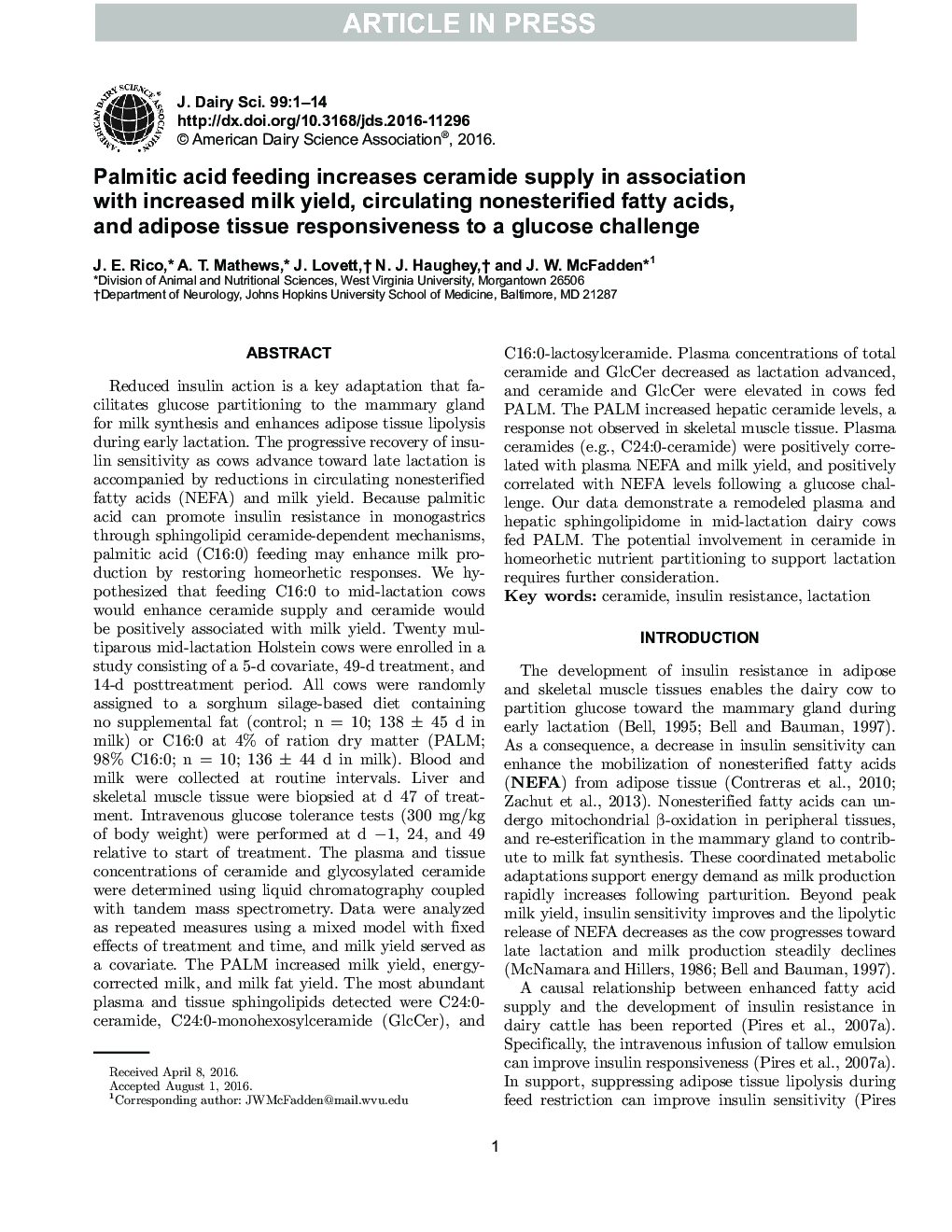| کد مقاله | کد نشریه | سال انتشار | مقاله انگلیسی | نسخه تمام متن |
|---|---|---|---|---|
| 5542656 | 1402521 | 2016 | 14 صفحه PDF | دانلود رایگان |
عنوان انگلیسی مقاله ISI
Palmitic acid feeding increases ceramide supply in association with increased milk yield, circulating nonesterified fatty acids, and adipose tissue responsiveness to a glucose challenge
ترجمه فارسی عنوان
تغذیه اسید پالمیتیک سبب افزایش عرضه سرامید در ارتباط با افزایش تولید شیر، گردش اسیدهای چرب غیر اسیدهای چرب و پاسخ بافت چربی به یک چالش گلوکز
دانلود مقاله + سفارش ترجمه
دانلود مقاله ISI انگلیسی
رایگان برای ایرانیان
کلمات کلیدی
سرامید، مقاومت به انسولین، شیردهی،
موضوعات مرتبط
علوم زیستی و بیوفناوری
علوم کشاورزی و بیولوژیک
علوم دامی و جانورشناسی
چکیده انگلیسی
Reduced insulin action is a key adaptation that facilitates glucose partitioning to the mammary gland for milk synthesis and enhances adipose tissue lipolysis during early lactation. The progressive recovery of insulin sensitivity as cows advance toward late lactation is accompanied by reductions in circulating nonesterified fatty acids (NEFA) and milk yield. Because palmitic acid can promote insulin resistance in monogastrics through sphingolipid ceramide-dependent mechanisms, palmitic acid (C16:0) feeding may enhance milk production by restoring homeorhetic responses. We hypothesized that feeding C16:0 to mid-lactation cows would enhance ceramide supply and ceramide would be positively associated with milk yield. Twenty multiparous mid-lactation Holstein cows were enrolled in a study consisting of a 5-d covariate, 49-d treatment, and 14-d posttreatment period. All cows were randomly assigned to a sorghum silage-based diet containing no supplemental fat (control; n = 10; 138 ± 45 d in milk) or C16:0 at 4% of ration dry matter (PALM; 98% C16:0; n = 10; 136 ± 44 d in milk). Blood and milk were collected at routine intervals. Liver and skeletal muscle tissue were biopsied at d 47 of treatment. Intravenous glucose tolerance tests (300 mg/kg of body weight) were performed at d â1, 24, and 49 relative to start of treatment. The plasma and tissue concentrations of ceramide and glycosylated ceramide were determined using liquid chromatography coupled with tandem mass spectrometry. Data were analyzed as repeated measures using a mixed model with fixed effects of treatment and time, and milk yield served as a covariate. The PALM treatment increased milk yield, energy-corrected milk, and milk fat yield. The most abundant plasma and tissue sphingolipids detected were C24:0-ceramide, C24:0-monohexosylceramide (GlcCer), and C16:0-lactosylceramide. Plasma concentrations of total ceramide and GlcCer decreased as lactation advanced, and ceramide and GlcCer were elevated in cows fed PALM. Palmitic acid feeding increased hepatic ceramide levels, a response not observed in skeletal muscle tissue. Plasma ceramides (e.g., C24:0-ceramide) were positively correlated with plasma NEFA and milk yield, and positively correlated with NEFA levels following a glucose challenge. Our data demonstrate a remodeled plasma and hepatic sphingolipidome in mid-lactation dairy cows fed PALM. The potential involvement in ceramide in homeorhetic nutrient partitioning to support lactation requires further consideration.
ناشر
Database: Elsevier - ScienceDirect (ساینس دایرکت)
Journal: Journal of Dairy Science - Volume 99, Issue 11, November 2016, Pages 8817-8830
Journal: Journal of Dairy Science - Volume 99, Issue 11, November 2016, Pages 8817-8830
نویسندگان
J.E. Rico, A.T. Mathews, J. Lovett, N.J. Haughey, J.W. McFadden,
